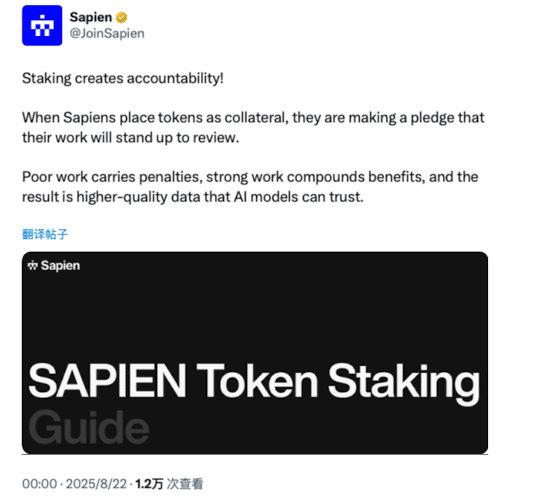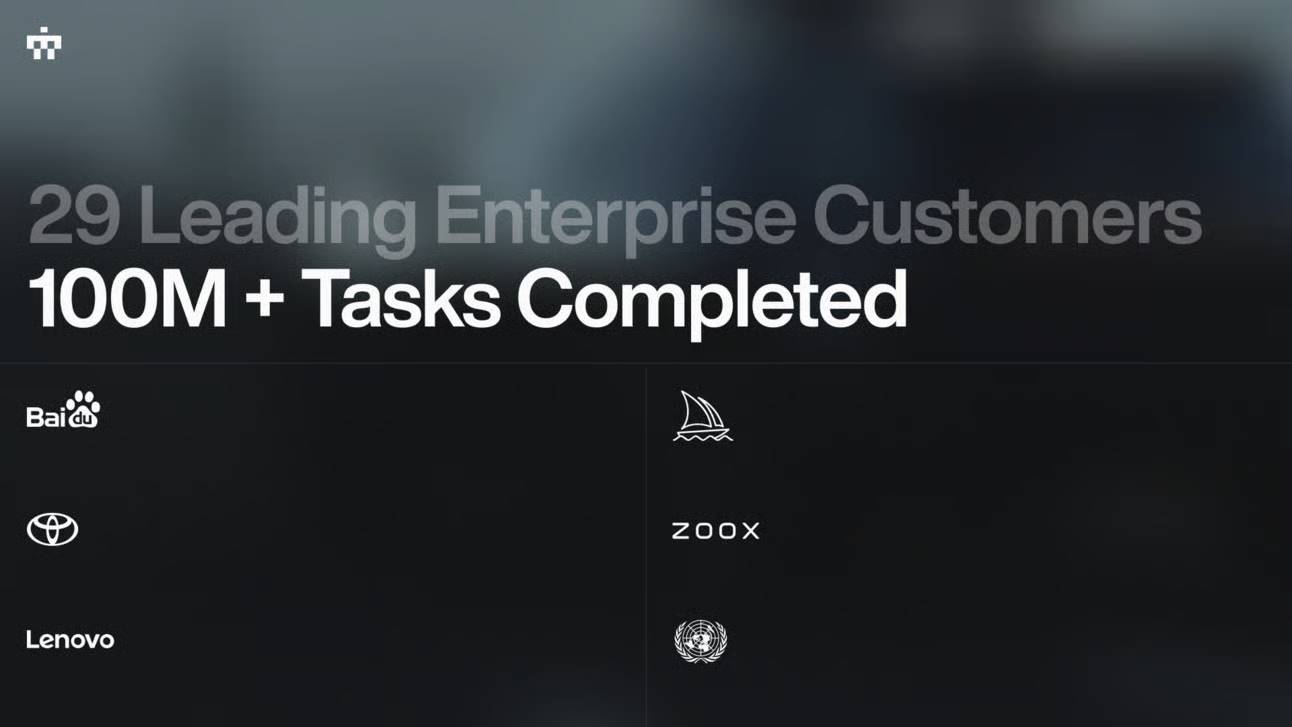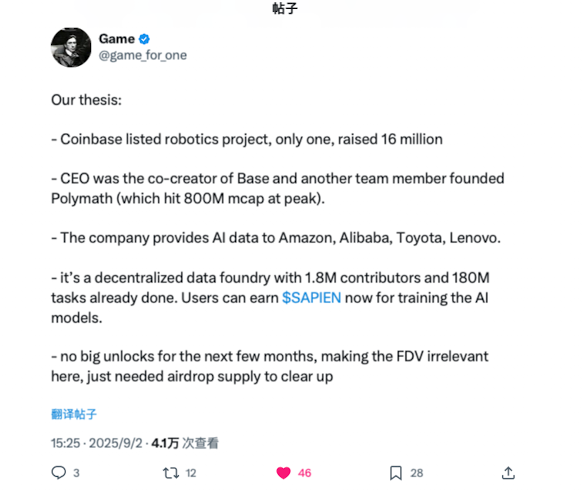Is the Base ecosystem getting a new star? A detailed look at the AI infrastructure project, Sapien.
Sapien, a decentralized AI data project on Base, has shown significant growth recently.
Following its Binance Alpha launch on August 20 (UTC), Sapien experienced a period of declines, but starting September 1, the project experienced a strong recovery. As of now, the Sapien token price has doubled, and 24-hour trading volume has jumped from about $5 million at the start of the month to over $20 million—a fourfold increase.
With rising prices and trading volume, market interest and conversations about Sapien have surged. The project’s public client roster includes household names from traditional industries—Alibaba, Baidu, Toyota, Lenovo—as well as the AI art unicorn, Midjourney.
Harnessing larger data sets for AI training and providing solutions for legacy Web2 enterprises remains an opportunity left behind in the last AI cycle. While the current crypto market’s AI narrative isn’t as intense as previous cycles, and most AI-related tokens lean toward meme status, Sapien offers a distinctly attractive story with real-world use cases.
Project Background
Community discussions around Sapien often highlight its “star team” as a key advantage.
Sapien CEO Rowan Stone is a former co-founder of Base, Coinbase’s Layer 2 network, giving Sapien an inherent edge within the Base ecosystem.
Chief Strategy Officer Trevor Koverko founded Polymath, a pioneering securities digitization project, and helped develop the ERC-1400 RWA standard. His expertise in asset tokenization is a major asset to Sapien’s development.

Sapien has raised $5 million in April 2024 and $10.5 million in October 2024 through two seed rounds. The latest round included notable investors like Primitive Ventures, Animoca Brands, and Yield Guild Games.
Beyond securing operational capital, these investments validate sustained market demand for decentralized AI data infrastructure—and indicate strong VC confidence in Sapien’s vision.
Sapien’s debut via Binance Alpha also speaks to its market appeal, with Alpha’s platform further boosting Sapien’s visibility in the industry.
Technical Innovation
Sapien tackles the chronic shortage of quality resources for AI training. This isn’t a new challenge, but Sapien’s approach is uniquely innovative.
Traditional AI data pipelines are plagued by murky sourcing, unpredictable quality, and weak incentives. Sapien’s Proof of Quality (PoQ) system introduces token staking, peer verification, reputation scoring, and incentive and penalty mechanisms to address these issues.
Contributors must stake Sapien tokens as collateral. After multi-party validation, they’re rewarded with Sapien tokens and stablecoins. Submitting poor-quality data can result in penalties of 25% to 100% of staked tokens forfeited.

This incentive structure curbs bot-based spamming and low-quality submissions, ensuring the platform only utilizes high-value data sets.
Sapien has already demonstrated usefulness in high-precision domains such as autonomous driving and medical diagnostics. For example, their published case studies show an oncology doctor earning several hundred dollars per hour for annotating cancer data. This underscores the enormous value of specialized, high-quality data. It also demonstrates the effectiveness of Sapien’s Proof of Quality (PoQ) mechanism in rewarding professional contributors.

(Image source: Sapien official website)
Market Scale
Sapien’s commercial progress is well ahead of its sector peers, having built a contributor network spanning over 110 countries worldwide.
The latest official data shows over 1.8 million registered contributors on Sapien’s platform, collectively completing more than 187 million data annotation tasks.

Even more impressive than the scale is the consistent growth, indicating market trust in Sapien’s model and brand. In 2024, contributor numbers grew by 50% month-over-month.
Sapien’s significance isn’t just in its user numbers, but also the strength of its enterprise client base. To date, Sapien has 29 enterprise clients—including Toyota, Alibaba, Baidu, Midjourney, and the United Nations—serving autonomous driving, e-commerce, AI imaging, and global organizations.

The partnership with Midjourney warrants particular attention. As a top project for AI-generated imagery, Midjourney is renowned for high-quality output, demanding the very best image data for its models. Only robust, diverse training sets make advanced AI art possible—so Midjourney choosing Sapien as its supplier confirms the reliability of Sapien’s data acquisition system.
Meanwhile, the involvement of established giants like Toyota and Alibaba signals that decentralized data services are gaining mainstream enterprise validation.
Base Ecosystem Support
Sapien’s success is closely linked to Base’s sweeping reforms in 2024, creating a self-reinforcing growth loop for both.
Base recently surpassed $6.8 billion in total value locked (TVL), overtaking Tron as the fifth-largest DeFi network. More than $2 billion belongs to AI-related protocols. Data from the Base App confirms that Base is making major bets on AI, solidifying Sapien’s position as a leader in AI infrastructure.
Sapien is expected to complement other AI projects within Base. For instance, Venice’s DIEM project focuses on tokenizing AI compute power, while Sapien specializes in verifiable human data. Together, they offer developers a complete infrastructure stack—this specialization and ecosystem coordination is Base’s unique L2 competitive edge.
Coinbase’s current strategy supports the trend: CEO Brian Armstrong recently shared that 40% of Coinbase’s code base is already AI-generated, aiming to reach over 50% by October 2025.

Base offers strong strategic and resource support to its ecosystem AI projects by combining internal AI adoption and external market momentum.
Market Sentiment and Discussion
Current social media and community debates reflect generally positive sentiment toward Sapien.
Key talking points include the potential value of AI data infrastructure in today’s global crypto and AI wave, the unique advantages of Sapien’s contributor network, and the strategic importance of partnerships with world-renowned enterprises.
Sapien’s Binance Alpha listing and early post-launch slump sparked brief controversy, but recent price gains have led to deeper market analysis that’s uncovered Sapien’s appeal and reliable fundamentals.
At the start of the month, ahead of Sapien’s price rally, an analyst known as Game posted an optimistic view based on Sapien’s credentials and data—interestingly, the price surged the day after his post.

Sapien: Strengths and Risks
Sapien’s recent performance has been noteworthy, but investment decisions require level-headed analysis.
On the upside, Sapien is solving real problems—demand for high-quality AI training data exists across industries. Its partnerships with major players like Alibaba and Toyota prove the model works.
Within the specialized AI training data market, Sapien enjoys first-mover advantage and a sizable footprint. A larger contributor base results in higher-quality data, establishing a positive feedback loop and strengthening competitive barriers. The Base ecosystem connection also gives Sapien an edge in resource access and business growth.
However, there are clear risks to consider.
First is the sustainability of the Proof of Quality (PoQ) mechanism. While sound in principle, maintaining high data growth may not last—once most AI models are trained, demand could drop sharply. As Sapien scales, the cost of maintaining data quality could rise rapidly; managing millions of contributors presents significant operational challenges.
Finally, Sapien faces the regulatory hurdles common to crypto projects: cross-border data, privacy, and AI compliance. Any lapse could result in disruption to the entire ecosystem.
Ultimately, as a key AI infrastructure component in the Base ecosystem, Sapien has attracted legitimate market attention for both its project and token.
With rapid AI development, surging data needs, and robust Base ecosystem backing, Sapien’s future is well worth watching.
Disclaimer:
- This article is reprinted from TechFlow. Copyright belongs to the original author [伞, Deep Tide TechFlow]. For copyright concerns, please contact the Gate Learn team for prompt resolution.
- Disclaimer: The views and opinions expressed are solely those of the author and do not constitute investment advice.
- Other language versions have been translated by the Gate Learn team. Translated content may not be copied, distributed, or plagiarized without proper reference to Gate.
Related Articles

Solana Need L2s And Appchains?

The Future of Cross-Chain Bridges: Full-Chain Interoperability Becomes Inevitable, Liquidity Bridges Will Decline

Sui: How are users leveraging its speed, security, & scalability?

Navigating the Zero Knowledge Landscape

What is Tronscan and How Can You Use it in 2025?
